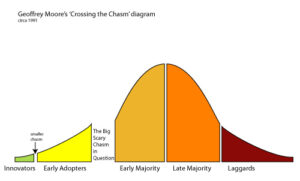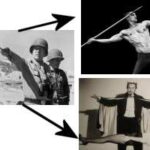First movers in a new industry or market are rarely the ones that become the dominant players as the industry or market matures. This is because first movers do not have a readymade market and are the ones that make all the business mistakes.
As a culture, we glorify the winners. As business owners, we often think the best path to success is to try and emulate the achievements of business winners. Unfortunately, most of us will fail in our endeavors because it is nearly impossible to replicate the conditions of the front-runner or market leader. Often what we perceive as a quick and decisive victory, was in-fact the results of a long drawn out war.
Being the first to market a truly innovative new product means you have to educate your customer about your value proposition. You often risk being too far out in front of the market and having to wait for it to catch up.

Moreover, of the 5 categories of adopters, Innovators and Early Adopters collectively represent only 16% of the market and value technology and performance. In contrast, the Early Majority, Late Majority, and Laggards represent the vast majority of adopters and value solutions and convenience.
Therefore, marketing to the first group requires a very different message than the message you want to send to the adopters in the second group.
Most front-runners often struggle with transforming their marketing focus as they try to change gears to attract the majority of adopters. Also, being the first to market means you will make lots of costly business mistakes that your competitors can learn from and then capitalize on at your expense.
Therefore, it is often far better to see what the market leader is doing and just be a little different in your value proposition. For example, when Chester Carlson invented the photocopier, it never really took off until the Haloid Corporation licensed the technology. Rather than sell copiers, Haloid Corporation leased them, which gave rise to Xerox. (See related post: New Product vs. New Economic Model)
In another example, Keurig (See related post: Keurig’s New Business and Economic Model) didn’t invent the coffee maker; it just changed its value proposition to essentially sell the coffee pot at cost and sell the coffee in the form of K-cups.
This is a particularly effective strategy when your customer segment is not very price sensitive and is very value-driven. This strategy works best when you sell premium products or services which no one else offers. If your product or service is being compared to alternatives, it is likely that you are not different enough. All too often I hear that we are better than the alternative, but this plays directly into the hands of the consumer as it changes the narrative from value to price.
When I was an Invisible Fencing dealer, some customers (especially the electrical engineer types) would look at the product and ask me why it cost so much since the sum of the parts and the underlining technology were pretty simple. To that objection, I would often reply, “It is not the sum of the parts or the revolutionary engineering that defines our product.” I would then explain that the technology was based on a simple AM radio technology and would encourage them to build their own DIY version if they had the time and energy to do so. However, I reminded them that we owned the patent and they could not manufacture a competing product.
Our product was also often compared to chain link and cyclone fences. Whenever potential customers brought up these options during my sales calls, I refocused their attention on our value proposition. When the prospect tried to compare our product to one of the alternative products by saying something like “but with your product it will not keep other dogs out” or “your product does not provide privacy from our neighbors” I’d redirect the discussion to our value and positioning and reply, “Aren’t you looking for product that will contain your dog that has no gates and requires no maintenance?” As you can see, I’d drive them away from the comparison and toward the unique values we provided.
In the end, differentiating your product has its own challenges, but your goal is to help the customer to mentally experience your product or service to a point where price becomes a secondary issue.
How can you capitalize on the business mistakes of the first mover or market leader?












